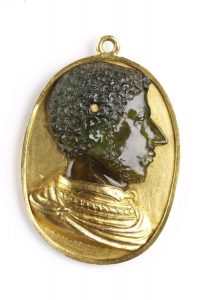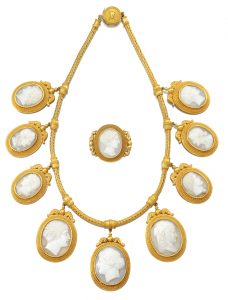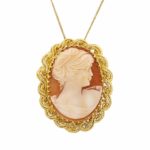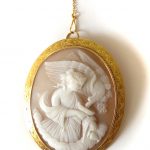Cameo jewellery is one of the most popular forms of displaying cameos. Prosperity in the Renaissance era lead to an increase in the demand for jewellery. Jewellery became part of the costume of the time and it was not long before the cameo sculptors took advantage of this by incorporating their artwork into jewellery.

The art of engraving gemstones can be traced back to ancient Greece in the 8th century BC and earlier. Techniques passed down to the Egyptians and then to the Romans. There were major revivals of interest in engraved gems in Europe during the Byantine era, the Middle Ages, the Renaissance, and again in the 18th and 19th centuries. At each stage cameos and intaglios, these skillful carvings on a minute scale, were much prized and collected, sometimes as symbols of power mounted in jewelled settings, sometimes as small objects for private devotion or enjoyment. The portrait above represents one of the powerful Florentine de’ Medici family, Alessandro de’ Medici. Alessandro, who lived from 1510-1537, is thought to have been the illegitimate son of Giulio de’ Medici, who later became Pope. It has been suggested that his mother was a servant, a black or Moorish freed slave. Alessandro was duke of Florence from 1530-37, when he was assasinated by his cousin. The cameo is part of a group of similar portrait medals and engraved gems generally thought to have been made by the medallist and gem-engraver Domenico di Polo (c.1480-1547). Domenico de Polo was appointed court medallist to both Alessandro and Cosimo de’ Medici. He engraved dies for portrait medals of both, and portraits of Alessandro in gemstones. Reference: Victoria and Albert Museum, London
Dating Cameo Jewellery
Unless the cameo is signed, it is very hard to date cameo jewellery. The best way is from the setting. Most cameos were set in gold or silver which may be hallmarked. The website Purely Silver may be able to help with this as it has a list of hallmarks and makers marks. Some cameos may be signed and if you can find out the maker, that is an excellent guide. A full gold hallmark follows the same letter system as silver but sometimes it only shows the carat. A lot of Georgian and Victorian jewellery was not hallmarked at all so it is also necessary to examine styles as well.
It would be very hard to find a genuine Ancient Roman or Ancient Greek cameo or even a Renaissance cameo. Most of these would be in museums so this site is mainly concerned with jewellery which may be found on the open market.
There probably isn’t a book or website anywhere which can tell you how to date a piece of jewellery with 100% accuracy. This is because fashions come and go and photos do not give the full story. The best way to get acquainted with the different styles throughout the years is to look and touch as many items as you can. This is not as difficult as it may seem. Museums such as the Victorian and Albert Musem and the British Museum have collections which go back to Prehistoric times. Even if you do not live near these there are other museums in all major cities throughout the world. Although you are not able to touch these exhibits, it is still possible to see their quality and settings.
Another way of examining jewellery items is by visiting local auction houses. This way you can not only view the items but pick up the items as well. General auctions are probably not the best way to learn because the items may not be catalogued and if they are catalogued, may only give a brief outline of the items. However a Fine Arts auction or Estate Auction would be required to catalogue their items accurately so it is an ideal way to get a feel of the items.
In general terms, if the item is set in gold and not hallmarked, there is a good possibility that it is 19th Century. The same applies to cameos set in silver. Another way of dating cameos is by the subject matter. Early 19th Century cameos often depicted mythical creatures, Bacchantes, Satyrs and archaeological motifs. The later Victorian era saw a revival in classical portraits of gods and goddesses. The noses of these figures can also help to distinguish the age.
After the death of Prince Albert in 1861, Queen Victoria went into mourning until she died in 1901. During this time black became the fashion including black jewellery. Cameos carved in black glass, Whitby Jet and French Jet also became popular.
If the setting of the item is made of pinchbeck the the item probably dates to around the 18th Century. Pinchbeck is an alloy of copper and zinc and was invented in the 18th Century by Christopher Pinchbeck. At the time it was the cheap alternative to gold but nowadays is highly collectable in its own right. Pinchbeck was rarely used during the 19th Century as it was replaced by gilt metal which was even cheaper than Pinchbeck.
If an item of cameo jewellery is stamped 15 carat gold, this is a good indication that the piece is Victorian.

The Gold Cameo demi-parure on the right dates to the Mid 19th Century. It comprises of a necklace of foxtail linking, suspending nine shell cameos depicting the profiles of classical ladies and gentlemen, within fine rope work borders. The length is approximately 330mm, and a brooch similarly-set. This set sold at Sotheby’s for 4,375 GBP


